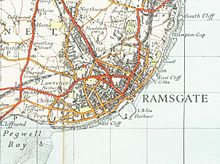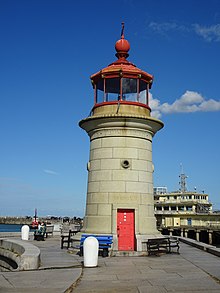| Port of Ramsgate | |
|---|---|
 | |
 Click on the map for a fullscreen view | |
| Location | |
| Country | England |
| Location | Ramsgate, Kent |
| Details | |
| Opened | 1850 |
| Operated by | Thanet District Council |
| Owned by | Thanet District Council |
| Land area | 32 acres (130,000 m2) |
| No. of berths | 3 |
| Berths in marina | 700 |
| Statistics | |
| Annual cargo tonnage | 1.59m tonnes (2009)[1] |
| Passenger traffic | 2,000,000 |
| Website www | |
The Port of Ramsgate (also known as Port Ramsgate, Ramsgate Harbour, and Royal Harbour, Ramsgate) is a harbour situated in Ramsgate, south-east England, serving cross-Channel freight traffic and smaller working and pleasure craft. It is owned and operated by Thanet District Council.
History
[edit]

The construction of Ramsgate Harbour began in 1749, and was completed in about 1850. The two most influential architects of the harbour were father and son John Shaw and John Shaw Jr, who designed the clock house, the obelisk, the lighthouse and the Jacob's Ladder steps.[2]

The harbour has the unique distinction of being the only harbour in the United Kingdom awarded the right to call itself a Royal Harbour. This was bestowed by King George IV after he was taken by the hospitality shown by the people of Ramsgate when he used the harbour to depart and return with the Royal Yacht Squadron in 1821.[3] In 2024 the harbour was designated a Heritage Harbour.[4]
Because of its proximity to mainland Europe, Ramsgate was a chief embarkation point both during the Napoleonic Wars and for the Dunkirk evacuation in 1940.
Passenger and freight services
[edit]Helped by its position 35 miles (56 km) from the French coast, the port provided cross-Channel crossings for many years,[5] with Ramsgate Port having its own access tunnel avoiding town centre congestion.
Ferries
[edit]
Previously Sally Ferries provided a service of passenger and car ferries to Dunkirk. From 1993 to 1997, Oostende Lines moved their operation from the Port of Dover to Ramsgate, before the state-owned company was closed, selling most of its assets to TransEuropa Ferries.
Between November 1998 and April 2013 a predominantly freight service was provided to Ostend by TransEuropa Ferries. Passenger services were only available on certain crossings, and then only with vehicles.[6]
Hovercraft
[edit]Hoverlloyd ran a crossing from Ramsgate Harbour to Calais from 6 April 1966 using small, passenger-only SR.N6 hovercraft. When the much larger SR.N4 craft, capable of carrying 30 vehicles and 254 passengers, were delivered in 1969, Hoverlloyd moved operations to the purpose-built Ramsgate Hoverport in Pegwell Bay, near Ramsgate, which closed in 1987.[7]
Recent years
[edit]Since 2013, there have been no ferry services from Ramsgate.[8] Between 2012–13 and 2014–15, the port recorded a loss of £2.7 million, and it was suggested it should be closed.[9] In 2016, Gefco commenced using the port to import and store cars prior to onward distribution.[10][11]
The port however continued to make losses, with a further loss of £2.5 million in the year 2018–19, and only limited activity in the commercial port.[12] In 2019, Seaborne Freight was awarded a £13.8m freight contract to Ostend which could be used in the event of a no deal Brexit, but this was ruled out as impractical.[13]
Royal Harbour Marina
[edit]
The Royal Harbour has a large marina, primarily based in the inner pool of the original harbour, with water levels controlled by lock gates containing 700 berths, although a number of other berths are also available in the outer harbour, and so can be accessed around the clock, rather than just either side of high tide when the gates open.[14]
The marina has a number of facilities for sailors, including refuelling, utility hook-ups and amenity blocks.[15]

The lighthouse situated on the West harbour arm was built in 1842 and is 11m high; it is a Grade II listed building.[16] The lighthouse is active and emits a continuous red light;[17][18] (originally the light varied from red to green depending on the height of the tide at the harbour entrance).[19] It replaced an earlier lighthouse by Benjamin Dean Wyatt, which had been poorly positioned and suffered damage from passing ships.[16] Now powered by electricity, originally it was lit by an oil lamp, with a fourth-order Fresnel lens.[19] Carved in the stonework of the lighthouse are the words 'PERFUGIAM MISERIS', which are translated as 'refuge for those in need'.[20]
Lifeboat station
[edit]A lifeboat station was first established at Ramsgate Harbour in 1802 by the trustees of the harbour,[21] predating the formation of any national lifeboat organisation by more than 20 years. The original was built by lifeboat pioneer Henry Greathead, in the same year that he was recognised by parliament for the lifeboat being "deemed a fit subject for national munificence".[22]
After a lapse in service between 1824 and 1851 a station was re-established by the trustees, with the lifeboat named in honour of the lifeboat sponsor, the Duke of Northumberland. The new and prized boat had been built in accordance with the plans of a model that had been the prize-winner in the 1851 national competition for the best design for such a craft.
In 1859 Jerimiah Walker (having previously distinguished himself by his successful rescue of the master and crew of the Northern Belle), as a seaman on the lugger Petrel, assisted in the rescue of the crew of the Spanish vessel Julia, which had become stranded off Ramsgate. For this assistance he was awarded a medal struck on the authority of Queen Isabella II of Spain.
On New Year's Day 1861 an event at sea of considerable loss of life occurred with the wreck of the Guttenburg. Then, as now, the most hazardous area around the Kent coastline for any navigator was the Goodwin Sands.
In 1865, the lifeboat was taken over by the Board of Trade and the Royal National Lifeboat Institution, and was taken over completely by the RNLI, which runs the service to this day.[21] The current lifeboat station, on the harbour wall between the inner and outer pools of the main harbour, opened in 1998 and services both an onshore lifeboat, the 'Bob Turnbull' and offshore lifeboat, the 'RNLB Esme Anderson'.[23][24][25]
Offshore wind farm
[edit]The Thanet Offshore Wind Project required the construction of a 280m quay for the assembly of wind turbines.[26] Turbines for the London Array are maintained from an operations and maintenance base at the port.
Walkway collapse
[edit]On 14 September 1994 there was a failure of a ship-to-shore structure for the transfer of foot passengers onto ferries. While RMT's Prins Filip was docked and loading vehicles and passengers, and getting readied for the voyage to Ostend in Belgium, the walkway collapsed, causing the deaths of six people and seriously injuring seven more. The investigation into the accident revealed that the same basic miscalculation had been made by both the designer (Swedish firm FKAB, a subsidiary of the Mattson Group) and certifying organisation Lloyd's Register. The parties involved, including the client, Port Ramsgate, were prosecuted and fined a total of £1.7m, which at the time was the largest fine in the United Kingdom for a breach of health and safety laws.[27] [28] [29] [30] [31] [32] [33][34] The Swedish firms refused to pay the £1m fine and as a result pan-European law enforcement was changed in 2005.[35][36]
See also
[edit]References
[edit]- ^ "Provincial Port Statistics 2009" (PDF). Department for Transport. 2009. p. 9.
- ^ "John Shaw Snr". Victorian Web.
- ^ "About the Marina". Port of Ramsgate.
- ^ "Heritage Harbour status for Ramsgate". ramsgatetown.org. 14 August 2024. Archived from the original on 3 September 2024. Retrieved 6 September 2024.
- ^ "Welcome to the Royal Harbour Marina". Port of Ramsgate.
- ^ "Website TransEuropa Ferries - History (page offline as operations stopped on 18-4-2013". Retrieved 3 May 2013.
- ^ "Pegwell Bay Hoverport, Ramsgate". .jameshovercraft.co.uk. Retrieved 11 October 2021.
- ^ "Thanet Gazette". Archived from the original on 10 June 2015. Retrieved 15 November 2013.
- ^ "Thanet council urged to close Port of Ramsgate as ferry terminal after it accumulated losses of £2.7m". Kent Online. 24 September 2015. Retrieved 26 October 2021.
- ^ "Ramsgate for Gefco". uk-ports.org, 8 February 2016. Archived from the original on 18 March 2016. Retrieved 11 October 2021.
- ^ Ramsgate back in business Ships Monthly January 2016 page 6
- ^ "Port of Ramsgate records losses of £2.5m, Kent Online". Archived from the original on 30 September 2020. Retrieved 30 September 2020.
- ^ "Ramsgate 'can not be ready' for Brexit ferries". BBC News. 6 January 2019. Retrieved 26 October 2021.
- ^ "Ramsgate - Information". Harbour Guides.
- ^ "Marina Facilities". Port of Ramsgate.
- ^ a b Historic England. "Lighthouse on West Pier (1086089)". National Heritage List for England. Retrieved 4 June 2019.
- ^ "Amateur Radio Lighthouse Society". Wlol.arlhs.com. Retrieved 13 August 2014.
- ^ Rowlett, Russ. "Lighthouses of Southeastern England". The Lighthouse Directory. University of North Carolina at Chapel Hill. Retrieved 13 August 2014.
- ^ a b "Lighthouse management : the report of the Royal Commissioners on Lights, Buoys, and Beacons, 1861, examined and refuted Vol. 2". 1861. p. 354.
- ^ "Perfugium Miseris". Ramsgate Town. Retrieved 4 June 2019.
- ^ a b "Station History". Royal National Lifeboat Institution Ramsgate. Archived from the original on 27 February 2012. Retrieved 31 August 2010.
- ^ Stephens, Alexander (1806). "7, Mr Henry Greathead, the inventor of the life-boat". Public Characters of 1806. Vol. VIII. London: Richard Phillips. pp. 181–208. Retrieved 19 November 2008.
- ^ "Boathouses". Royal National Lifeboat Institution Ramsgate. Archived from the original on 28 September 2009. Retrieved 31 August 2010.
- ^ "RNLB Esme Anderson". Royal National Lifeboat Institution Ramsgate.
- ^ "Bob Turnbull". Royal National Lifeboat Institution Ramsgate. Archived from the original on 9 October 2011. Retrieved 31 August 2010.
- ^ "Fear for wind farm impact on port". BBC News. 21 December 2006.
- ^ "Ferry walkway disaster blamed on inept design". The Independent. London. 24 January 1997.
- ^ "Largest UK safety breach pay-outs". BBC News. 7 October 2005.
- ^ "Paying the price of safety failures". BBC News. 27 July 1999.
- ^ "Ramsgate Walkway Disaster". Hansard. 311 (c406W). 6 May 1998.
- ^ "HSE publishes report of the walkway collapse at Port Ramsgate". 28 January 2000.
- ^ "Ramsgate port operators guilty". The Independent. London. 18 February 1997.
- ^ Chapman, J.C. (1998). "Collapse of the Ramsgate Walkway". The Structural Engineer. 72 (1): 1–10.
- ^ Chapman, J.C. (1999). "Lessons from the Collapse of the Ramsgate Walkway". Forensic engineering: A professional approach to investigation. pp. 27–38. doi:10.1680/feapati.27879.0004. ISBN 0-7277-2787-7.
- ^ "European Review Issue 18 page 6". Tueip.dircon.co.uk. Retrieved 13 August 2014.
- ^ Rennie, David (25 February 2005). "New EU law means no escape for drivers caught speeding abroad". The Daily Telegraph. London.